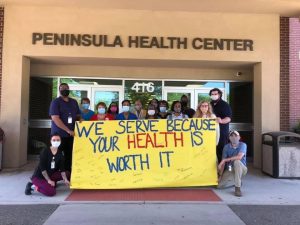About Us
The Hampton & Peninsula Health Districts' Population Health staff work with a wide range of community partners focused on promoting and improving the health of residents in our community. Our Population Health team works to understand the issues that affect health in all of our localities and seeks better health through active participation of local residents and partners.
What is Public Health 3.0?
1.0
Population Health strives to create a more equitable world to create capital "H" health. This is part of public health 3.0's philosophy, which the Hampton-Peninsula Health District is transitioning to adopt. Public Health 1.0 refers to the period from the late 19th century through much of the 20th century when modern public health became an essential governmental function with specialized federal, state, local, and tribal public health agencies. During this period, public health systematized sanitation, improved food and water safety, expanded our understanding of diseases, developed powerful prevention and treatment tools such as vaccines and antibiotics, and expanded capability in epidemiology and laboratory science.
2.0
Public Health 2.0 emerged in the second half of the 20th century and was heavily shaped by the 1988 Institute of Medicine (IOM) IOM report, The Future of Public Health. In that report, the IOM posited that public health authorities were encumbered by the demands of providing safety-net clinical care and were unprepared to address the rising burden of chronic diseases and new threats such as the HIV/AIDS epidemic. The focus of public health became preventing chronic diseases and unhealthy lifestyles in order to prevent long-term medical illnesses.
3.0
Public Health 3.0 refers to a new era of enhanced and broadened public health practice that goes beyond traditional public department functions and programs. Cross-sectoral collaboration is inherent to the Public Health 3.0 vision. In this approach, local communities are building upon historic success at health improvement, and adding a focus on social and environmental determinants of health to achieve health equity. This is done through deliberate cross-collaboration across sectors, especially non-traditional partners.

Social Determinants of Health
Population Health is built on an understanding of the social determinates of health within the general population. Social determinants of health (SDOH) are the conditions in the environments where people are born, live, learn, work, play, worship, and age that affect a wide range of health, functioning, and quality-of-life outcomes and risks. Assessment of the determinants impact on health and the development of strategies to address those factors that may be causing poor health is the work of Population Health. SDOH can be grouped into 5 domains: Economic Stability, Education Access, Quality Health Care Access, Quality Neighborhood and Built Environment, and Social and Community Context

What is the Community Health Assessment and Improvement Plan (CHA-CHIP)?
The CHA-CHIP is an acronym for Community Health Assessment and Improvement Planning. It's a community-wide process that involves identifying the most important health factors in a community and developing a plan to improve health. The plan is based on the results of a community health assessment (CHA) and is often called a community health improvement plan (CHIP).
The CHA is a systematic process that involves collecting and analyzing data to understand health in a community. This data can help identify problems and assets, and inform policy formulation, implementation, and evaluation. The CHA can also help measure how well a public health system is performing.
The CHIP is a long-term effort to address public health problems based on the CHA results. It involves developing strategies to address priority issues, bringing together resources and stakeholders, and creating a shared framework for community health. The CHIP should ensure that priorities are relevant to the community and that objectives and strategies are S.M.A.R.T. . Strategies are often carried out by community partners and tracked using an online dashboard. The CHIP is typically updated every three to five years.
We work with the Peninsula Community Health Collaborative, a network made up of: The Hampton & Peninsula Health Districts, Bon Secours, the Children's Hospital of The King's Daughters, Riverside Health System, and Sentara Healthcare to complete our Community Health Assessment.
You can view our Community Health Assessment and Community Health Improvement Plan below.
FROM OUR GALLERY









Statistics and Data
Part of Population Health's work is to measure the health statistics and data within our communities. Some of the forms of measurement include direct measurement through programs, and others involve national data rankings and health statistics.
County Health Rankings
The Rankings were developed by the University of Wisconsin Population Health Institute and the Robert Wood Johnson Foundation. Within each state, the counties (cities) were ranked on two sets of measures: health outcomes (length and quality of life) and health factors (health behaviors, access to and quality of clinical care, social and economic factors, and the physical environment). The Rankings were developed to increase awareness of the many factors that contribute to the health of communities. The first set of the Rankings was released in February 2010. For more detail on the County Health Rankings visit www.countyhealthrankings.org.
Virginia Division of Health Statistics
The Virginia Department of Health’s Division of Health Statistics provides access to summary reports compiled from vital records: birth certificates, marriage certificates, death certificates, etc. Specific reports or the entire annual report are available here.
Reportable Diseases
Health district level data on reportable diseases, primarily communicable infectious diseases, are available from the Virginia Department of Health’s Office of Epidemiology: Virginia Monthly Morbidity Surveillance Report by District and Region. The Division of Disease Prevention provides more detailed surveillance data here.
